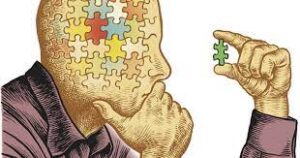Recognizing Perinatal Mood or Anxiety Disorders


There are so many pressures that come with being a new parent. It often feels like there’s an expectation for things to ‘come naturally’ and be filled with overwhelming joy and love. The reality of bringing a new life into the world is filled with tectonic physical changes and intense emotions of all kinds. This can make it difficult to talk about maternal mental health, as most moms feel the pressures of stigma surrounding their less-than-perfect experience. During May, which is Maternal Mental Health Awareness Month, we want to establish a new normal; one in which all parents can openly acknowledge both amazing and challenging aspects of parenthood, and advocate for individuals who experience perinatal mood or anxiety disorders.
Pressures of Parenthood
The transition to parenthood is challenging in one way or another for almost everyone. So many changes happen during this time: sleep, relationships, work, schedules, and other areas of life can have significant shifts. It can be hard to know what a ‘normal adjustment’ is when you are feeling tired and overwhelmed as you adapt to these big changes. Feelings of shame or embarrassment can come up if the transition feels harder than you expected or if you’re not feeling the “glow” of new parenthood that is often romanticized in our society. However, it is normal to feel this way, and you are not alone in this.
We tend to be hard on ourselves and put the blame on a lack of something inside us rather than realizing the struggles could be an indication of a medical condition and not a sign of failure. Additionally, each person’s experience of parenthood is unique. For some, bonds and adjustment come fairly easily, while for others, it may be more difficult. Neither of these experiences are the “right” one.
The intensity of these changes and the onslaught of emotion and pressure can make it difficult to recognize when a perinatal mood or anxiety disorder (PMAD) is present, so it is important to know the signs and symptoms, and the differences from normal ‘baby blues.’
Baby blues vs perinatal mood or anxiety disorder (PMAD)
Research shows up to 80% of new parents experience some mood swings and weepiness during the first 2-3 weeks of parenthood. This is often labeled “the baby blues” and will resolve without any medical assistance.
Up to 20% of women can continue to struggle past this period and experience more significant symptoms of depression during their pregnancy or postpartum period. About 6% of pregnant women and about 10% of postpartum women have anxiety, intrusive repetitive thoughts, panic, or post-traumatic stress. Sometimes women experience anxiety alone, but others can experience both anxiety and depression during this period. Postpartum Psychosis, where the mother’s thoughts are significantly altered and often scary, occurs in approximately 1 to 2 out of every 1,000 deliveries. The media often calls postpartum psychosis depression, but it is a separate and unique illness. Any of these reactions can also occur with miscarriage, abortion, stillbirth, or infant loss.
When someone starts to feel sad, worried, or not interested in activities that used to bring them joy, and experience several other symptoms (discussed next) they may be experiencing PMAD. You may feel more irritable, agitated, or overwhelmed rather than sad or nervous. Other symptoms might include insomnia or sleeping most of the time, appetite changes, restlessness, feelings of hopelessness or worthlessness, difficulty concentrating, and physical symptoms such as dizziness, rapid heartbeat, or aches and pains that last beyond typical recovery from birth.
Risk factors for PMAD include a personal or family history of anxiety or depression, previous depression or anxiety, or thyroid imbalance. When symptoms move to this level of intensity seeking outside support is important and there are many research backed treatments that work very well.
Comparison of Baby Blues vs. PMAD
| Baby Blues | PMAD | |
| When it starts | After birth (can start while at the hospital) | During pregnancy or up to one year postpartum |
| How long it lasts | A few days, up to three weeks | Longer than three weeks |
| Typical symptoms | Mood is generally happy or calm with bouts of moodiness, tearfulness, anxiety and/or sadness
Trouble concentrating |
Mood predominantly sad, anxious, or irritable with some of the following symptoms: scary thoughts, hopelessness, feelings of guilt, problems sleeping, fatigue, loss of interest in activities typically enjoyed, changes in appetite, trouble making decisions or trouble concentrating |
When to seek help
Consider reaching out for help if your emotions make it difficult to:
- Parent effectively
- Take care of yourself effectively (including getting enough sleep or eating well)
- Perform daily tasks or complete work tasks
Other important signs you should reach out for help:
- Thinking about hurting yourself or your child
- Feeling like you are often reexperiencing a traumatic birth experience, pregnancy loss or other past traumatic event
- Frequent bouts of crying
- Feeling hopeless or worthless
- Experiencing persistent scary thoughts such as your baby being harmed or you harming your baby
- Worrying that you are “losing your mind” or “going crazy”
- Feeling like you have not been able to bond with your child and/or you are not fit to be a parent
Conclusion
Perinatal mood or anxiety disorders are temporary and treatable with professional help for both moms and dads. The transition to parenthood is tough on us all but if it reaches a level described above it’s important to reach out for help. Treatment typically includes some combination of increased and targeted self-care, social support, therapy, and/or treatment of symptoms with medication when necessary.
Self-care is aimed at increasing resilience during a time in which so much mental and physical burden is placed upon you. It includes proper rest, good nutrition, assistance with baby and other children, and caring for personal needs such as exercise, relaxation, or time with partner/spouse. Building up your support team for a wide range of supports is important during this time. Talking with a counselor or therapist who understands perinatal mental health disorders can be extremely beneficial. There are several research backed treatments that can help you improve your mood, cope more effectively during the transition to parenthood, and develop the relationship with your child(ren) and partner that you want.
Resources:
Postpartum Support International: https://www.postpartum.net/
World Maternal Mental Health Day – May 7, 2025: https://wmmhday.postpartum.net/
Pine Rest Mother and Baby Day Program: https://www.pinerest.org/day-programs/mother-baby-program/
Pine Rest Resource: Understanding PMAD: https://www.pinerest.org/media/Understanding-PMAD.pdf
University of Michigan Women and Infants Mental Health Program: https://medicine.umich.edu/dept/psychiatry/programs/women-infants-mental-health
Zero to Thrive Clinic: https://zerotothrive.org/clinical-services/perinatal-psychiatry-clinic/
Book recommendation: Mom Brain, Ilyse Dobrow DiMarco, PhD: https://www.amazon.com/Mom-Brain-Strategies-Overwhelming-Motherhood/dp/1462540260
Resources in the Community
Nature’s Playhouse: https://www.naturesplayhouse.com/
Honey for Moms: https://www.honeyformoms.com/
Scarff JR. Postpartum Depression in Men. Innovations in Clinical Neuroscience. 2019 May 1;16(5-6):11-14. PMID: 31440396; PMCID: PMC6659987.
Kim P, Swain JE. Sad dads: paternal postpartum depression. Psychiatry (Edgmont). 2007 Feb;4(2):35-47. PMID: 20805898; PMCID: PMC2922346.
















Recent Comments